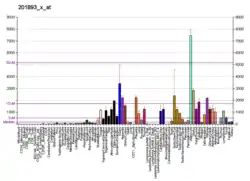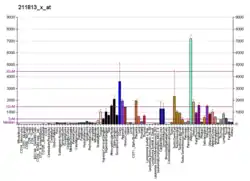دکورین
دکورین (انگلیسی: Decorin) نام پروتئینی است که در انسان توسط ژن «DCN» کد میشود.
وزن مولکولی این پروتئین کوچک، بهطور معمول ۹۰ تا ۱۴۰ کیلو دالتون است و در ماتریکس سلولی یا خارجسلولی قرار داشته و از لحاظ ساختار شبیه به بایگلایکن است و تصور بر آن است که این دو پروتئین، حاصلِ پدیدهٔ مضاعف شدن ژن باشند.
دکورین یکی از اجزای بافت همبند بوده و به رشتههای باریکِ کلاژن نوع ۱ متصل شده در ساخت ماتریکس برونیاختهای شرکت دارد.[4]
میزان این پروتئین در کلوئید در مقایسه با پوست سالم، کمتر است.[5]
دکورین در تنظیم خودخواری و لایه درون رگی نقش دارد و از رگزایی جلوگیری میکند.
در سالهای اخیر یک نقش القاکنندهٔ ساخت ماهیچه (میوکین) هم برای آن قائل شدهاند که از طریق اتصال به میوستاتین، موجب هایپرتروفی عضلانی میشود.[6]
منابع
- GRCm38: Ensembl release 89: ENSMUSG00000019929 - Ensembl, May 2017
- "Human PubMed Reference:". National Center for Biotechnology Information, U.S. National Library of Medicine.
- "Mouse PubMed Reference:". National Center for Biotechnology Information, U.S. National Library of Medicine.
- "Entrez Gene: DCN decorin".
- Jumper N, Paus R, Bayat A (Sep 2015). "Functional histopathology of keloid disease". Histology and Histopathology. 30 (9): 1033–57. doi:10.14670/HH-11-624. PMID 25900252.
- Kanzleiter, T; Rath, M; Görgens, SW; Jensen, J; Tangen, DS; Kolnes, AJ; Kolnes, KJ; Lee, S; Eckel, J; Schürmann, A; Eckardt, K (2014). "The myokine decorin is regulated by contraction and involved in muscle hypertrophy". Biochem Biophys Res Commun. 450: 1089–1094. doi:10.1016/j.bbrc.2014.06.123. PMID 24996176.
- مشارکتکنندگان ویکیپدیا. «Decorin». در دانشنامهٔ ویکیپدیای انگلیسی، بازبینیشده در ۲۴ دسامبر ۲۰۱۷.
جستارهای وابسته
- Ständer M, Naumann U, Wick W, Weller M (May 1999). "Transforming growth factor-beta and p-21: multiple molecular targets of decorin-mediated suppression of neoplastic growth". Cell and Tissue Research. 296 (2): 221–7. doi:10.1007/s004410051283. PMID 10382266.
- Fujisawa R (Mar 2002). "[Recent advances in research on bone matrix proteins]". Nihon Rinsho. Japanese Journal of Clinical Medicine. 60 Suppl 3: 72–8. PMID 11979972.
- Krumdieck R, Höök M, Rosenberg LC, Volanakis JE (Dec 1992). "The proteoglycan decorin binds C1q and inhibits the activity of the C1 complex". Journal of Immunology. 149 (11): 3695–701. PMID 1431141.
- Winnemöller M, Schön P, Vischer P, Kresse H (Oct 1992). "Interactions between thrombospondin and the small proteoglycan decorin: interference with cell attachment". European Journal of Cell Biology. 59 (1): 47–55. PMID 1468447.
- Murphy-Ullrich JE, Schultz-Cherry S, Höök M (Feb 1992). "Transforming growth factor-beta complexes with thrombospondin". Molecular Biology of the Cell. 3 (2): 181–8. doi:10.1091/mbc.3.2.181. PMC 275517. PMID 1550960.
- Pulkkinen L, Alitalo T, Krusius T, Peltonen L (1992). "Expression of decorin in human tissues and cell lines and defined chromosomal assignment of the gene locus (DCN)". Cytogenetics and Cell Genetics. 60 (2): 107–11. doi:10.1159/000133314. PMID 1611907.
- McBride OW, Fisher LW, Young MF (Feb 1990). "Localization of PGI (biglycan, BGN) and PGII (decorin, DCN, PG-40) genes on human chromosomes Xq13-qter and 12q, respectively". Genomics. 6 (2): 219–25. doi:10.1016/0888-7543(90)90560-H. PMID 1968422.
- Fleischmajer R, Fisher LW, MacDonald ED, Jacobs L, Perlish JS, Termine JD (Feb 1991). "Decorin interacts with fibrillar collagen of embryonic and adult human skin". Journal of Structural Biology. 106 (1): 82–90. doi:10.1016/1047-8477(91)90065-5. PMID 2059554.
- Pulkkinen L, Kainulainen K, Krusius T, Mäkinen P, Schollin J, Gustavsson KH, Peltonen L (Oct 1990). "Deficient expression of the gene coding for decorin in a lethal form of Marfan syndrome". The Journal of Biological Chemistry. 265 (29): 17780–5. PMID 2211661.
- Yamaguchi Y, Mann DM, Ruoslahti E (Jul 1990). "Negative regulation of transforming growth factor-beta by the proteoglycan decorin". Nature. 346 (6281): 281–4. doi:10.1038/346281a0. PMID 2374594.
- Greve H, Blumberg P, Schmidt G, Schlumberger W, Rauterberg J, Kresse H (Jul 1990). "Influence of collagen lattice on the metabolism of small proteoglycan II by cultured fibroblasts". The Biochemical Journal. 269 (1): 149–55. doi:10.1042/bj2690149. PMC 1131544. PMID 2375748.
- Roughley PJ, White RJ (Sep 1989). "Dermatan sulphate proteoglycans of human articular cartilage. The properties of dermatan sulphate proteoglycans I and II". The Biochemical Journal. 262 (3): 823–7. PMC 1133347. PMID 2590169.
- Fisher LW, Termine JD, Young MF (Mar 1989). "Deduced protein sequence of bone small proteoglycan I (biglycan) shows homology with proteoglycan II (decorin) and several nonconnective tissue proteins in a variety of species". The Journal of Biological Chemistry. 264 (8): 4571–6. PMID 2647739.
- Yamaguchi Y, Ruoslahti E (Nov 1988). "Expression of human proteoglycan in Chinese hamster ovary cells inhibits cell proliferation". Nature. 336 (6196): 244–6. doi:10.1038/336244a0. PMID 3194009.
- Krusius T, Ruoslahti E (Oct 1986). "Primary structure of an extracellular matrix proteoglycan core protein deduced from cloned cDNA". Proceedings of the National Academy of Sciences of the United States of America. 83 (20): 7683–7. doi:10.1073/pnas.83.20.7683. PMC 386785. PMID 3484330.
- Fisher LW, Hawkins GR, Tuross N, Termine JD (Jul 1987). "Purification and partial characterization of small proteoglycans I and II, bone sialoproteins I and II, and osteonectin from the mineral compartment of developing human bone". The Journal of Biological Chemistry. 262 (20): 9702–8. PMID 3597437.
- Lysiak JJ, Hunt J, Pringle GA, Lala PK (Apr 1995). "Localization of transforming growth factor beta and its natural inhibitor decorin in the human placenta and decidua throughout gestation". Placenta. 16 (3): 221–31. doi:10.1016/0143-4004(95)90110-8. PMID 7638106.
- Takeuchi Y, Kodama Y, Matsumoto T (Dec 1994). "Bone matrix decorin binds transforming growth factor-beta and enhances its bioactivity". The Journal of Biological Chemistry. 269 (51): 32634–8. PMID 7798269.
- Scholzen T, Solursh M, Suzuki S, Reiter R, Morgan JL, Buchberg AM, Siracusa LD, Iozzo RV (Nov 1994). "The murine decorin. Complete cDNA cloning, genomic organization, chromosomal assignment, and expression during organogenesis and tissue differentiation". The Journal of Biological Chemistry. 269 (45): 28270–81. PMID 7961765.
- Danielson KG, Fazzio A, Cohen I, Cannizzaro LA, Eichstetter I, Iozzo RV (Jan 1993). "The human decorin gene: intron-exon organization, discovery of two alternatively spliced exons in the 5' untranslated region, and mapping of the gene to chromosome 12q23". Genomics. 15 (1): 146–60. doi:10.1006/geno.1993.1022. PMID 8432526.
- Bredrup C, Knappskog PM, Majewski J, Rødahl E, Boman H (Feb 2005). "Congenital stromal dystrophy of the cornea caused by a mutation in the decorin gene". Investigative Ophthalmology & Visual Science. 46 (2): 420–6. doi:10.1167/iovs.04-0804. PMID 15671264.
This article is issued from Wikipedia. The text is licensed under Creative Commons - Attribution - Sharealike. Additional terms may apply for the media files.





